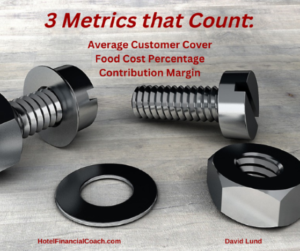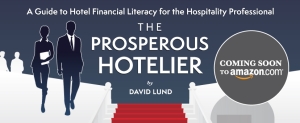
What counts and Why?
 If you do not have all three of these metrics on your radar screen at the same time, you are flying the profit picture in your food operation with at least one eye closed. All three metrics must work together at the same time to get the best view of the potential profitability of your food sales. Let’s explore these three different measurements and see what we find.
If you do not have all three of these metrics on your radar screen at the same time, you are flying the profit picture in your food operation with at least one eye closed. All three metrics must work together at the same time to get the best view of the potential profitability of your food sales. Let’s explore these three different measurements and see what we find.
Average Customer Cover
The first part is “average customer cover spend” or ACCS. That is the average amount of food sales per person served. To calculate this, you take the total food sales (only items in the food family) from a given period and divide it by the number of customers served in the same period. In the Uniform System of Accounts for the Lodging Industry 11th Edition we moved away from average cover to the average customer calculation. The difference is in the past we would exclude customer covers for people who did not consume food, now we include all customers served.
Basically, we are now including customers in the average customer calculation who only have a drink, but we do not include the drink revenue in the ACCS calculation. I am not sure it is better but that’s what is in the book says so let’s all do things the same way, please.
This calculation in my opinion is only slightly important. It proves two things: Is my pricing strategy and menu mix effective for getting more spend from each customer? Does the average customer spend going up or down? That is all it tells you. No insights on the cost of sales or profitability. It is the least effective measurement of the three when it comes to understanding profitability.
Food Cost Percentage
The second is food cost, aka, cost of goods sold. From my days as a food and beverage controller, these words are welded into my brain. Opening food inventory (food family), plus food purchases, less closing inventory, less any legitimate credits for things like the cafeteria, promotion or food to bars, plus beverage to food. This is a very meaningful calculation. It is the raw gross profit number from the food operation before labor costs and expenses. It is the beginning of the profit story. This number expressed as a percentage is typically somewhere between 20-30% in hotels with full-service operations. I have seen it as low as the high teens and as high as the mid-30s on an annualized basis.
Normally in a hotel, the food cost percentage depends largely on volume. The volume of banquets is the best card to draw here. Great banquet business with lots of breakfasts, coffee breaks and receptions, and you probably have a month with a good food cost.
On the flip side, if have a month with low banquets and restaurants that are busy with lunch and dinner, it is not such a great picture. The food cost is the chef’s responsibility. I say that because in more than one hotel I have been associated with there was confusion on the chef’s part. Some believed accounting was responsible for the food cost. The chef buys the food, cooks the food and ultimately has the greatest influence on the outcome. TAG, you’re it.
Having a good or bad food cost can also be a bit of a smoke and mirrors job. Several factors can influence food cost:
- Purchasing prepared items vs. raw production equals lower labor cost and higher food cost
- Meal plans, revenue allocations and consumption
- How well are the meal plan packages controlled and accounted for?
- Room sale inclusions of a food nature that are not consistent with the 11th Edition that favor a pure or reduced food revenue allocation in favor of room revenue
- Packages that include a food component, like the mighty Bed and Breakfast
- Food inventory: frequency, policy, and consistency
Contribution Margins
The third part of my radar screen is the most powerful and, in my experience, the least understood aspect: food contribution margin. It is the inverse of the food cost relationship.
When you boil it down, it is: What’s my gross profit from the sale of my food item? Which one do I get the highest contribution from, and which ones can I sell most frequently?
It is also the little items that are add-ons that generate a great margin, like coffee, certain appetizers, desserts and juice. This is a powerful concept to teach your service and catering staff. Which items on the menu drive the highest dollar margin and which add on items, if sold, drive the contribution dollars? Remember we don’t take percentages to the bank – we take $$$.
So, imagine if a catering customer came to you and said, “I have a limited budget of $2,000 for my meeting.”
What would you try and sell them?
- Lunch?
- Fresh muffins and doughnuts?
- Energy bars and nutritional snacks?
- Breakfast fruit and pastries?
- A late afternoon cocktail reception?
- A wine and cheese cocktail?
- Or a coffee break?
- What would your sellers suggest?
Each one of these has a very different cost of sales and the inverse “contribution margin.” If your sellers are informed and focused, they can help clients with what they need for their event and many times, make some of their selections one of the higher contributing items. I know some chefs that send their conference service and catering managers an email every quarter with the top 10 things to sell. They also make a point of joining the dining room line-up once a week to highlight the high contributing items. If you and I were selling cars, we ought to know the ones that garner the highest margin. The other aspect of an effective strategy to maximize the contribution is to zero in on the top items to sell that require the least labor.
When it comes to contribution margin and dollars in a hotel, the one item that often floats to the top of the performance list is coffee. Think about it. At $200 a gallon in some hotels or $4 a cup, the margin is huge. If you even think about providing it as a value add or a package, you might want to re-think your strategy. Coffee is king on contribution, and it also has a very positive impact on food cost and in some cases – like restaurants – the ACCS.
When we look at a pure restaurant play and menu items, we always want to look at the metric of what sells and what does not sell. We also want to be keenly aware of what sells the best with the highest contribution margin. I might have a NY strip that I sell for $40. It costs me $12 so my food cost is 30%, but my contribution is $28. Compare this to my salmon entrée, that sells for $28 and costs me $7. My food cost on the salmon is 25% but my contribution is only $21. I want to feature the steak and make sure all my wait staff know what to sell first.
Back to the add-ons
With the add-ons, we might be forgetting the impact they can create on profitability. Here is a notable comparative trend. Recently in the airline business much has been said and not all of it popular by any means about the additional fees for luggage, seat selection, headphones, food, boarding preference, and even now that carry-on bag costs a minimum of $20 with most carriers.
All of this is completely a page from the restaurant and banquet book. We had this figured out a century ago and I think we have lost sight of its potential positive impact on profitability. Dig a little deeper into this airline story and it is the single biggest reason for the profit improvement that they have recently experienced. Hotels need to never lose sight of this already built-in phenomena that we have: Add-ons that positively impact the contribution and profit margin because they are highly profitable. We already have the customer in the seat.
We have a core offering, a menu item that has an attractive price to get the customer in the house and the opportunity to add on, to sell and to greatly enhance our profitability. We can offer items that are attractive with low ticket prices that have correspondingly high contribution margins. Let’s pretend you and I order a salmon and that NY steak. Our waiter suggests an appetizer and after dinner coffee. We bite on one bruschetta to share, and I go for the coffee.
What just happened to the average customer cover, the food cost? What happened to the contribution/gross food profit?
The bruschetta sells for $8 and costs $1. The coffee for $4 and costs $.50.
My average customer cover just went from $34 to $40. This is great. My food cost went from 28% for the entrées alone down to 26% with all four items. Nice. Drum roll…. My contribution or gross profit before labor or expenses on this table of two just went from $49 to $59.50 – a $10.50 improvement with no additional labor and only a cup, two saucers and some additional cutlery to clean. That is a 21.4% increase in my contribution margin. That is $10.50 more in my bank account tonight. Cha Ching!
In summary, remember:
Average cover is only an indication of pricing and menu mix, not profit. Food cost percentage is important but what we are really after is the contribution margin and knowing what products drive this. And focusing our sellers on these is the key to profitability.
Nickle and dime and watch the profit climb. Know which cars on your lot to sell first.

Coming Soon in 2022 – The Prosperous Hotelier
Complimentary Discovery Call – https://calendly.com/hotelfinancialcoach/introduction
Video Course Links:
https://hotelfinancialcoach.com/video-course/
https://hotelfinancialcoach.com//hotelfinancialcoach.com//www.ahla.ca/financial-leadership-david-lund/
https://hotelfinancialcoach.com//hotelfinancialcoach.com//video.tourismworks.ca/en/financial-leadership
Be sure to check out my other services on the links below.
On-line Strategic Hospitality Financial Leadership Workshops
The 3 Month 1-1 Financial Leadership Mentoring Program
Hotel Accounting Policy Manuals
Hotel Asset Management Program
Strategic Hospitality Financial Leadership Workshops
415 696 9593 – Cell or Text
Read a Story About How I Helped a Client
Give the coach a call today and let’s get going!
If you would like a copy of the following send me an email at
-
Incentive Plan Template
Visit my website today for a copy of my FREE guidebook
The Seven Secrets to Create a Financially Engaged Leadership Team in Your Hotel
www.hotelfinancialcoach.com
